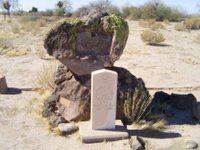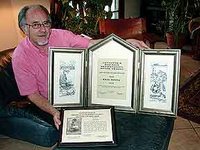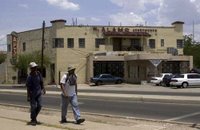 [Source: Florence Reminder] -- The final resting place of Granville Oury, Arizona's congressional delegate to the Confederacy and holder of other important positions in the Arizona Territory, is in the AOUW Cemetery on Adamsville Road (pictured at left). The inscription on the monument appears to be missing, either through vandalism or neglect. In the distance are the fenced graves of Florence pioneers John B. and Carmen Michea. Among many others buried here is Sidney Bartleson, first cousin to Harry Truman. To the east is the Butte Views cemetery. APS is researching and negotating to find whether it can site a power line on these historic cemeteries.
[Source: Florence Reminder] -- The final resting place of Granville Oury, Arizona's congressional delegate to the Confederacy and holder of other important positions in the Arizona Territory, is in the AOUW Cemetery on Adamsville Road (pictured at left). The inscription on the monument appears to be missing, either through vandalism or neglect. In the distance are the fenced graves of Florence pioneers John B. and Carmen Michea. Among many others buried here is Sidney Bartleson, first cousin to Harry Truman. To the east is the Butte Views cemetery. APS is researching and negotating to find whether it can site a power line on these historic cemeteries.Local historic preservationists are watching closely to see how a new APS power line will possibly encroach on two historic cemeteries on Adamsville Road, across from the Florence Indian Village. The affected cemeteries are the Butte Views Cemetery, consisting of just over five acres and badly overgrown with brush; and the AOUW cemetery to west of it, which is approximately four acres. Laid to rest here are many prominent pioneers and other early Florence residents who died in the late 1800s and early 1900s.
Until recently both cemeteries were owned by groups which apparently no longer exist. The Florence Rotary Club obtained the Buttes View cemetery in 2000 through a quit-claim deed. The club obtained the deed with the goal of beautifying the cemetery, but it remains heavily overgrown. APS has been unable to find a current owner of the AOUW (Ancient Order of United Workmen) cemetery with whom to negotiate, according to Jeff Creedon, an APS supervisor. He said the company hasn't made any final decisions, and wishes to address concerns including historic preservation. "We'll work through it with all the concerned parties; that's what we do," Creedon said. [Note: To read the full article, click here.]








